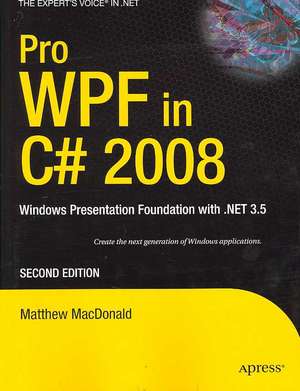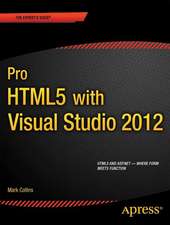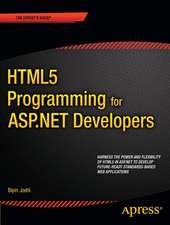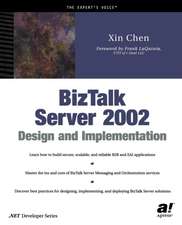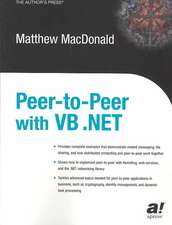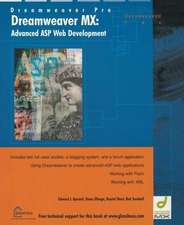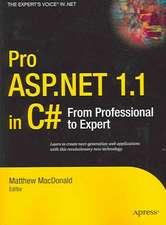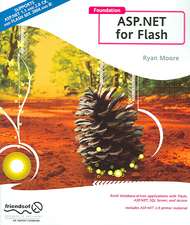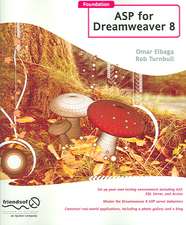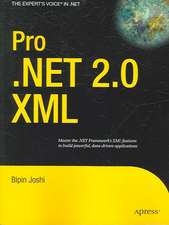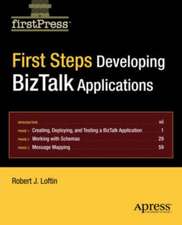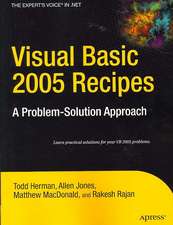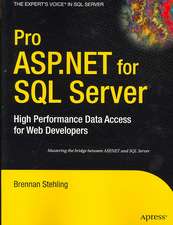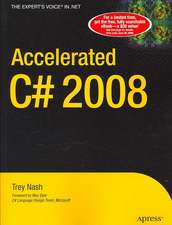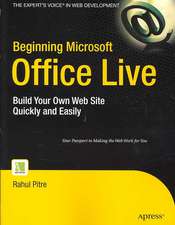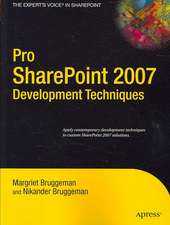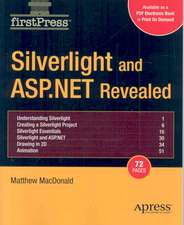Pro WPF in C# 2008: Windows Presentation Foundation with .NET 3.5
Autor Matthew MacDonalden Limba Engleză Paperback – 7 mar 2008
In this book, author Matthew MacDonald shows you how WPF really works. His no-nonsense, practical advice will get you quickly and easily building high-quality WPF applications. MacDonald takes you through a thorough investigation of the more advanced aspects of WPF, and its relation to other elements of the WinFX stack and the .NET Framework 3.5, to complete your understanding of WPF and C# 2008.
Preț: 310.07 lei
Preț vechi: 387.58 lei
-20% Nou
59.34€ • 61.64$ • 49.29£
Carte disponibilă
Livrare economică 11-25 ianuarie 25
Specificații
ISBN-10: 1590599551
Pagini: 1040
Ilustrații: 1040 p.
Dimensiuni: 178 x 235 x 58 mm
Greutate: 1.84 kg
Ediția:2nd ed.
Editura: Apress
Colecția Apress
Locul publicării:Berkeley, CA, United States
Public țintă
Popular/generalCuprins
A table of contents is not available for this title.
Notă biografică
Matthew MacDonald is an author,educator, and MCSD developer who has a passion for emerging technologies. He isthe author of more than a dozen books about .NET programming. In a dimly-remembered past life, he studied English literature and theoretical physics.
Caracteristici
Goes deep into the core of the technology in 1000 pages of content-rich explanation
Written by Matthew MacDonald, author of two highly successful books on WPF's predecessor technology and with a proven track record of explaining breaking technologies clearly and precisely (c.f. Pro ASP.NET 3.5)
Descriere
When .NET first appeared, it introduced a small avalanche of new technologies. There was a whole new way to write web applications (ASP.NET), a whole new way to connect to databases (ADO.NET), new typesafe languages (C# and VB .NET), and a managed runtime (the CLR). Not least among these new technologies was Windows Forms, a library of classes for building W- dows applications. Although Windows Forms is a mature and full-featured toolkit, it’s hardwired to essential bits of Windows plumbing that haven’t changed much in the past ten years. Most significantly, Windows Forms relies on the Windows API to create the visual appearance of standard user interface elements such as buttons, text boxes, check boxes, and so on. As a result, these ing- dients are essentially uncustomizable. For example, if you want to create a stylish glow button you need to create a custom c- trol and paint every aspect of the button (in all its different states) using a lower-level drawing model. Even worse, ordinary windows are carved up into distinct regions, with each control getting its own piece of real estate. As a result, there’s no good way for the painting in one c- trol (for example, the glow effect behind a button) to spread into the area owned by another control. And don’t even think about introducing animated effects such as spinning text, sh- mering buttons, shrinking windows, or live previews because you’ll have to paint every detail by hand.
